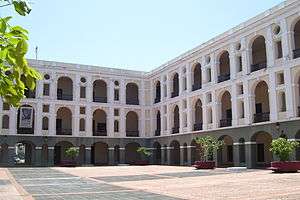Ballajá Barracks
Ballajá Barracks (or Cuartel de Ballajá in Spanish) is a military barracks located in San Juan, Puerto Rico. It was built from 1854 to 1864 for the Spanish troops established on the island and their families.

Construction
The Ballajá Barracks were built by the Spanish militia from 1854 to 1864. To build it, six blocks from the Ballajá ward were expropriated from the Dominican Order and demolished in 1853. The three-story structure was completed in 1864, occupying an area of 7,700 square meters (83,000 sq ft). It could accommodate over 1,000 citizens, originally Spanish soldiers and their families. Its vast interior patio is one of the best examples of 19th-century Spanish architecture.
Other than the housing facilities, the barracks had storage rooms, kitchens, mess halls, dungeons, and horse stables.
Spanish–American War
The barracks were heavily used during the Spanish–American War near the end of the 19th century. On May 12, 1898, during the American bombing of San Juan, the fleet led by Admiral William T. Sampson damaged the northeast side of the barracks.
After the war ended, and with the change of sovereignty, the barracks became the quarters for the United States Army until 1939.
World War II
During World War II, the barracks were used as a military hospital, under the name of Army General Hospital of Fort Brooke. On August 31, 1944, the United States Department of War issued General Order No. 71 which renamed the hospital as Rodriguez (161st) General Hospital, in honor of Major Fernando E. Rodríguez Vargas.
Government acquisition
The Government of Puerto Rico acquired the building in 1976 through a transfer from the Government of the United States with the commitment of restoring it and using it for cultural, educative, and touristic purposes. In 1986, a reform plan for the San Juan Historic Zone was sketched and the building was restored from 1990 to 1993.
Today
Today, the Ballajá Barracks houses several educational and cultural organizations, namely the Museo de Las Américas on the second floor of the building since 1992. On the first floor, there are music and dance schools and a library, among other things.
The Museo de Las Américas has three permanent collections: African Heritage, the Indian in America, and Popular Arts in America.